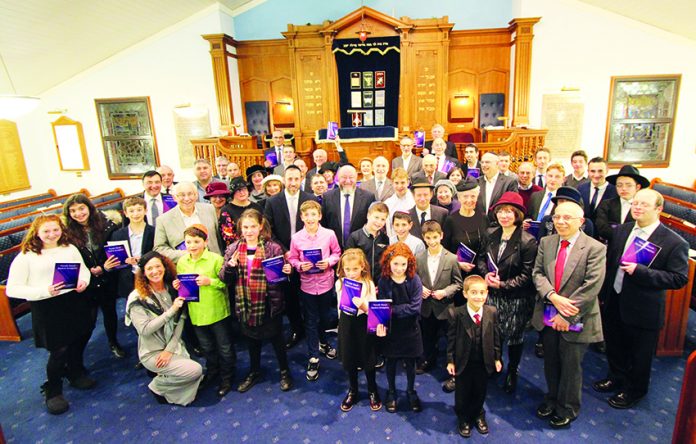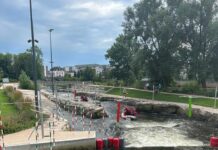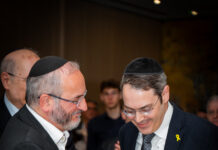
By David Saffer
Tottenham Hotspur and Celtic could face each other in the forthcoming UEFA Champions League at Wembley Stadium next season.
One might wonder how this could impact on Woodside Park Synagogue members, which boasts one of the largest communities of the United Synagogue, standing currently at around 1,400.
Part of the northwest London Eruv with Barnet and Mill Hill, Rabbi Pinchas Hackenbroch has been its minister since 2008; but prior to this posting, he began his rabbinic career at Newton Mearns Synagogue in Glasgow, home city to Rangers and the mighty Celtic.
A huge sports fan, particularly football, Rabbi Hackenbroch follows the fortunes of Tottenham.
A former amateur player of NW Neasden, he came out of retirement to score a goal for a Rabbi XI side that lost 9-2 against a Tottenham legends team in a charity Laniado event last September. And whilst at Newton Mearns he represented a Members of Parliament football team that included MPs from London and MSPs from Scotland for charity, so he might have split loyalties.
This is a sporting rabbi who cites major triumphs as lessons of inspiration in sermons and will probably have a comment or two should this powerhouse fixture north and south of the border clash in the group stages. But it will be in good taste with a spiritual meaning!
Just under eight decades ago North Finchley and Woodside Park was an informal Jewish community.
High Holiday services took place at the home of Max Sebba, a well-known philanthropist in Totteridge. As the community became established, services moved to Alexander Grove, when it became admitted to the United Synagogue in 1943.
Early ministers included Rabbi Sydney Leperer and Rabbi Cyril Shine.
During the 1950s it acquired its present site, which had been a Victorian Masonic temple and a fire station during the World War.
The Masonic temple was converted into a synagogue in 1964.
Spare land was developed to include a communal hall and classrooms, named after Rev Linden and Chazan Wiseman, who both died in a fatal car crash after officiating at a funeral in November 1956.
Following the tragedy, Jews College responded at short notice to provide a chazan who could also read from the Torah.
Teenager Michael Plaskow stepped forward and went on to serve the shul as chazan for 43 years. He and his family have settled in Israel since his retirement.
The original Victorian building had two sections. The front half, rebuilt in 1985, accommodates the shul, which incorporates stained glass windows from the former New Cross Synagogue in South London. The shul also keeps alive the memory of Sunderland Beit Hamidrash through its Aron Kodesh and bimah. The back section, rebuilt a decade later, is a three-floor community centre that includes a kindergarten and youth facilities.
Rabbi Hackenbroch hails from Stanmore and attended Hasmonean High School prior to reading Law at London Guildhall University.
He fondly recalls attending Stanmore Synagogue, where his father was a warden, and his respect for its rabbi, Rabbi Dr Jeffrey Cohen.
“My family were very involved and I wanted to give something back to the community, so it was just a question of which way I was going to do it,” Rabbi Hackenbroch said.
A rabbinical path was his choice, which began at yeshivot in Israel after university studies.
Whilst obtaining semichah, Rabbi Hackenbroch graduated in practical rabbinics through the Ner Le’elef Institute and Kollel Halichot in Jerusalem at the turn of the millennium.
During this period, he married his wife, Gila Elevitsky, whose father was rabbi of the Mizrachi Shul in Antwerp, in 1997.
Rabbi Hackenbroch was appointed Rabbi of Newton Mearns Synagogue in 2003.
“I’d never been to Glasgow but we were struck by the warm welcome of the community,” he recalled. “They were receptive, supportive and up for the challenge.
“The move was the right opportunity at the right time. We could see there was a genuine desire to work with us and build the community together. As a result, membership increased for the first time in a number of years, so we were very lucky.”
The Hackenbrochs were renowned as hosts and for providing dynamic educational and social programmes, including a learning initiative called ‘60 days for 60 years,’ which tackled contemporary Jewish issues and attracted over 1000 people.
Head of kashrut for west of Scotland, Rabbi Hackenbroch was a sought-after speaker at inter-communal and interfaith events.
“It’s special when one goes to a first pulpit, and an advantage of a post, particularly in the provinces, is you don’t have the infrastructure of the United Synagogue, so you are involved in every aspect of the Jewish and wider communal life,” he recalled.
“It enabled me to learn on the job all aspects of being a communal leader.
“Being in Scotland, there was a different culture, it’s a different way of life.
“We were exposed to everything under the sun, from anti-racism and interfaith events to representing Scottish Jewry on national and royal occasions.
“Travelling across Scotland was a huge learning curve. I learned so much.”
Rabbi Hackenbroch took up his post at Woodside Park just under a decade ago.
“It was the right time to move on and no reflection on the Glasgow community,” he recalled.
“When we arrived the Woodside Park community was in a state of flux. There had been a rift between various groups so the first mission was to rebuild, galvanise and unify the community, which took a couple of years, but since then we have grown in all directions.
“Our membership has increased, and the amount of programmes we do are at the forefront of many of the most dynamic, which other communities try to emulate.”
In terms of educational programmes, shuirim and discussion groups are available on a plethora of topics for members of all ages.
There is also a huge range of educational and social activities for youth and young families.
With the shul attracting members from Totteridge to West Finchley and further afield, it is on an upward trend that it aims to continue.
So how have Shabbat services, which attract 200 people when there is no simchah, developed?
“Nothing stands still in communal life. At present we have one main service, then children, toddler, youth and intermediate services,” Rabbi Hackenbroch explained.
“Occasionally, we have young family services as well, but we also have ‘squads,’ for boys and girls, which have been duplicated in the United Synagogue. Children who attend learn about specific subject matters, and the squads have proved exceptionally popular.”
The Hackenbrochs have six children, and they are renowned for an open-door policy and for being extremely approachable.
Away from shul life, Rabbi Hackenbroch practices as both a commercial and family mediator on panels, with law firms and charities to advise and resolve their disputes.
He is also a frequent contributor in the press, social media and on radio.
Rebbetzin Hackenbroch is a highly respected psychotherapist as well, working for the charities Camp Simcha and Noah.
In Glasgow, she worked for Relate as a therapist, lectured for UJIA and was the liaison between Glasgow and London Beth Din.
A popular speaker with ladies and teenage girls at Woodside Park, Rebbetzin Hackenbroch was instrumental in Shabbat UK and other high-profile social programmes, and for several years she has coordinated the ladies learning programme, New Moonies.
Woodside Park has a commitment to care and the Hackenbrochs are naturally involved in this field.
Rebbetzin Hackenbroch assists in facilitating the Woodside Park Bereavement Group (The Kaddish Club) and Woodside Park Cares.
“Lay chaplains visit patients from our community at Barnet Hospital and The Kaddish Club meets regularly,” Rabbi Hackenbroch explained.
“People grieving have an opportunity to share as a group experience.
“We have a voluntary care coordinator to help in the various needs of the community, which includes volunteers going to Reubens House, a local Jewish care home.”
Known for thought-provoking and inspiring sermons and shiurim, Rabbi Hackenbroch’s innovative Learning without Limits guest speakers programme is now in its fifth year.
So how does he approach putting together an inspirational sermon for congregants?
“I keep up to date with what is going on in the news,” he explained.
“The subject matter has to be something that is on people’s minds, what concerns them. If it doesn’t touch them, if it’s not relevant, then it will be a big turn-off, so I’m always trying to find issues or current affairs that are directly relevant to people’s lives.
“But sometimes we don’t have a sermon. You have to be flexible so we do discussions or debates on everything and anything under the sun.
“You cannot be one dimensional as a rabbi anymore. You have to vary your approach.
“On a recent sabbatical, I met different communities around the world and it gave me new insights. My eyes were opened seeing what is going on. It offered a different dimension and you become more dynamic.
“A danger is that you can be insular, inward focused and tied up with our own work, which does not enable you to venture out to develop.”
In terms of future challenges, he noted, “We’ve pretty much outgrown our facilities at Woodside Park so we would like to rebuild at least part of the site.
“We must also deepen our engagement with our already vibrant community. Reaching out to more people is the next stage of our development as a shul.”
As for demographics, Rabbi Hackenbroch describes his congregation as “a perfect bell.”
“Having been an established community there is a broad spectrum of adults, but we also have 450 kids,” he explained.
“Young families are constantly moving into the area, and we are particularly encouraged by the numbers of young members that have come forward to take up lay leadership roles. They are giving back and making a mark, which is encouraging for the future.
“But the key is to try to create even more leaders because every person has a role unique to the community. I’m always approaching people at a simchah, or if somebody comes through our doors, to find ways where they can find fulfilment giving something back to our community that would enrich us and enrich their lives.
“The great positive is that we are a community, there is a true sense of harmony and unity together with care and concern for every member.
“Members from all walks of life want to play a role, and that is what makes us so special.”









